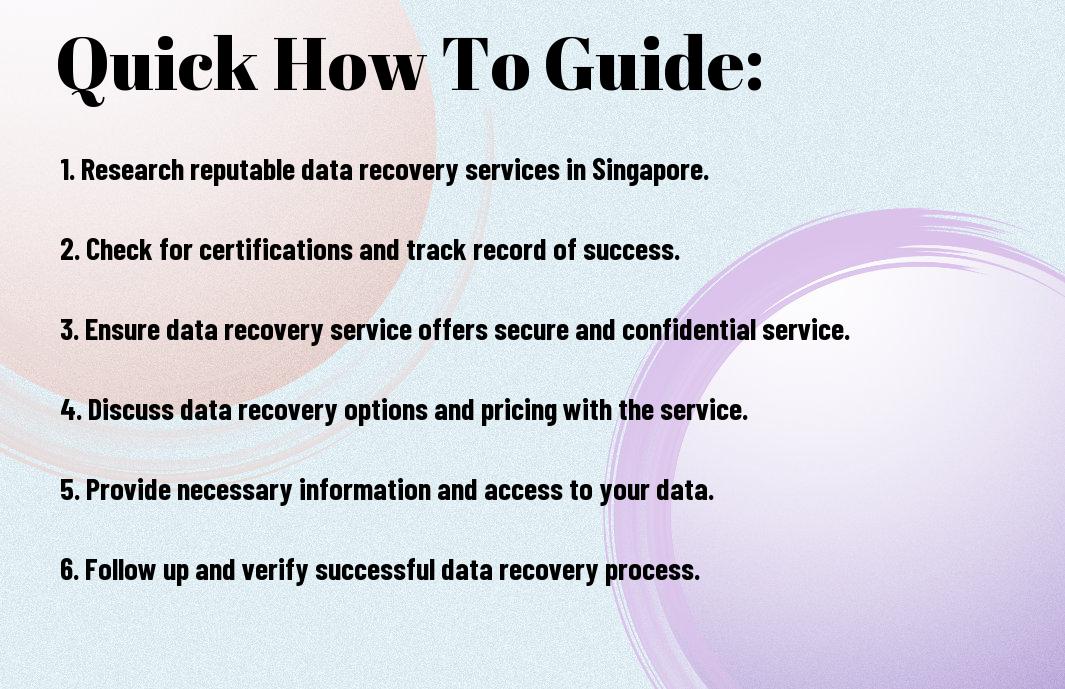Preserving your digital information is paramount in today’s interconnected world. With the ever-evolving cyber threats and potential data breaches, it is essential to have a solid data protection plan in place. In this guide, we will explore into the most effective strategies to safeguard your data and introduce you to the best data recovery service in Singapore. By implementing these practices and enlisting the help of reputable professionals, you can ensure the integrity and security of your valuable information.
Key Takeaways:
- Choose a reputable data recovery service: Ensure that the data recovery service in Singapore you choose has a proven track record of successfully recovering data from various storage devices.
- Check for certifications and experience: Look for data recovery services that have certifications in data recovery and years of experience in the field. This will give you assurance that they have the expertise to handle your data recovery needs.
- Regularly back up your data: To minimize the risk of data loss, it is important to regularly back up your data on an external hard drive, cloud storage, or another secure location. This ensures that you have a copy of your important data in case of an unexpected data loss event.
Understanding Data Loss
Clearly, data loss is a significant concern for individuals and businesses alike. It can happen unexpectedly, leading to serious consequences if not addressed promptly and effectively. In this chapter, we will investigate into the common causes of data loss and how to identify signs of data compromise to safeguard your valuable information.
Common Causes of Data Loss
Causes of data loss can range from hardware malfunctions and software corruption to human error and cyberattacks. Accidental deletion of files, hardware failure, power outages, and natural disasters such as floods or fires are common factors contributing to data loss. Additionally, malware and ransomware attacks can encrypt or steal sensitive data, making it inaccessible to users.
One must also consider the impact of physical damage to storage devices like hard drives or SSDs, which can result in data becoming unreadable or irretrievable. It is crucial to have robust backup strategies in place to mitigate the risks associated with data loss and ensure business continuity.
Identifying Signs of Data Compromise
One of the key indicators of data compromise is unusual activity on your computer or network. This includes sudden slowdowns, frequent crashes, unauthorized access to files, or unfamiliar programs running in the background. If you notice any of these signs, it is imperative to investigate further to determine if your data security has been breached.
A proactive approach to cybersecurity involves regularly monitoring your systems for any suspicious behavior and employing encryption methods to protect sensitive data. Being vigilant and proactive in detecting signs of data compromise can help prevent potential data loss and safeguard your digital assets effectively.
How-To Choose the Right Data Recovery Service
Assuming you have experienced data loss and are in need of professional help to recover your important files, selecting the right data recovery service is crucial. With so many options available, it can be challenging to determine which service provider will best meet your needs and ensure a successful data recovery process.
Factors To Consider When Selecting a Service Provider
When choosing a data recovery service, there are several key factors to take into consideration. Experience and expertise in the field of data recovery are essential, as well as the technologies and methods they use. Reputation and customer reviews can also give you valuable insights into the quality of their services. Any data recovery service you consider should offer a free evaluation of your device to assess the extent of the damage and provide a clear overview of the recovery process.
- Experience and expertise
- Technologies and methods used
- Reputation and customer reviews
Tips for Verifying Credibility and Expertise
Service providers claiming to be experts in data recovery should be able to demonstrate their certifications and affiliationssuccess rate of the service provider in recovering data from similar devices or situations. Recognizing these credentials and achievements can help you make an informed decision when entrusting your data to a recovery service.
- Certifications and affiliations
- Success rate in similar recoveries
When vetting a data recovery service, it is essential to go beyond just their claims and investigate their track record and customer feedback. Recognizing the signs of a reputable and skilled service provider can prevent further damage to your data and improve the chances of successful recovery. Selecting the right data recovery service is an important decision that requires careful consideration and thorough research to safeguard your valuable information.
- Track record and customer feedback
- Signs of a reputable and skilled service provider
Safeguarding Your Data Proactively
With the increasing amount of data generated and stored digitally, it is more important than ever to proactively safeguard your valuable information from potential loss. Implementing effective data backup strategies and following best practices for data protection are crucial steps in ensuring the security and integrity of your data.
How-To Implement Effective Data Backup Strategies
Your data backup strategy should include regular, automated backups of all important data to both on-site and off-site locations. This ensures that in the event of hardware failure, cyber attacks, or accidental deletion, your data can be easily recovered. It is also recommended to test your backups regularly to ensure they are functioning properly and the data can be restored successfully when needed.
Tips for Data Protection and Avoiding Future Losses
Avoiding data loss incidents can be achieved by implementing best practices for data protection. This includes encrypting sensitive information, restricting access to confidential data, and regularly updating software and security protocols to prevent cyber threats. Any data loss prevention strategy should also include educating employees on proper data handling procedures and the importance of data security.
- Regularly backup your data to multiple locations.
- Encrypt sensitive information to protect it from unauthorized access.
- Keep your software and security protocols updated to prevent cyber threats. Any.
Recovering Data: The Process
Unlike regular file backups, data recovery is the process of salvaging lost, inaccessible, corrupted, or formatted data from storage devices. It requires specialized knowledge, software tools, and techniques to recover the lost data without causing further damage or permanent loss. Choosing the best data recovery service in Singapore can make a significant difference in retrieving your valuable information successfully.
Initial Consultation and Evaluation
One of the first steps in the data recovery process is the initial consultation and evaluation of the storage device. A professional data recovery service will assess the extent of the damage, the likelihood of successful data recovery, and provide you with a detailed quote for the service. They will also advise you on the best course of action and the potential risks involved in the recovery process.
During the evaluation, the data recovery experts will determine the cause of data loss, whether it is due to physical damage, logical errors, accidental deletion, or virus infection. This information is crucial in devising a customized data recovery plan that maximizes the chances of recovering your valuable data within the shortest time possible.
The Recovery Operation Steps and Techniques
Recovering data involves a series of systematic steps and techniques to retrieve lost information successfully. These steps may include creating a bitwise copy of the storage device to prevent further data loss, repairing damaged or corrupt sectors, and using specialized software tools to extract and reconstruct the lost data. The recovery operation may also involve advanced techniques such as file carving, which helps in recovering fragmented or partially overwritten files.
A crucial aspect of the recovery operation is ensuring that the retrieved data is intact and free from errors or corruption. Data recovery experts use specialized validation tools to verify the integrity of the recovered files and folders before presenting them to the client. This meticulous process ensures that the recovered data is accurate, complete, and in a usable format, meeting the client’s expectations and requirements.
After the Recovery: Ensuring Data Integrity
How-To Validate Recovered Data
The successful recovery of data is only the first step in the process of safeguarding your important information. Validating recovered data is crucial to ensure that the data retrieved is accurate and complete. One effective way to validate the integrity of the recovered data is to perform checksum verification. This involves calculating a unique checksum value for the recovered data and comparing it with the original checksum value. If the two values match, it indicates that the data has not been altered during the recovery process.
Another method to validate recovered data is to conduct file integrity checks. By comparing the contents of recovered files with their original versions, you can identify any discrepancies or corruption that may have occurred. It is essential to thoroughly validate the recovered data to prevent the risk of data corruption or loss in the future.
Best Practices for Post-Recovery Data Management
For enterprises and individuals alike, implementing best practices for post-recovery data management is crucial to maintaining the integrity and security of recovered data. One key practice is to establish regular data backups to prevent future data loss incidents. Storing backups in separate locations and utilizing encryption for sensitive information can further enhance data protection.
Additionally, conducting periodic data audits and implementing access controls can help mitigate the risks of unauthorized data access or tampering. It is essential to stay vigilant and proactive in managing recovered data to ensure that it remains secure and accessible when needed.
With proper validation and management practices in place, you can safeguard your recovered data effectively and minimize the potential threats to its integrity. By following these guidelines, you can enhance the reliability and security of your data recovery efforts, providing peace of mind knowing that your valuable information is well-protected.

Conclusion
Presently, safeguarding your data is of utmost importance, and having a reliable data recovery service is crucial. With the best data recovery service in Singapore, you can ensure that your valuable information is protected and easily retrievable in case of any data loss. By entrusting your data to a reputable service provider, you can have peace of mind knowing that your files are in safe hands and can be recovered efficiently whenever needed. Don’t wait until it’s too late – invest in a reliable data recovery service to safeguard your important data today.
FAQ
Q: Why is data recovery important?
A: Data recovery is important because it helps individuals and businesses retrieve vital information that may have been lost due to accidental deletion, hardware failure, or malware attacks. By using a reliable data recovery service, you can safeguard your valuable data and prevent potential losses.
Q: How can I choose the best data recovery service in Singapore?
A: When selecting a data recovery service in Singapore, look for a company with a proven track record of successful data retrievals, experienced technicians, secure facilities, and transparent pricing. It’s essential to choose a service provider that prioritizes data security and confidentiality to ensure the safe recovery of your data.
Q: What steps can I take to prevent data loss in the future?
A: To prevent data loss in the future, you can regularly back up your data using reliable storage solutions, such as cloud storage or external hard drives. Implementing robust cybersecurity measures, updating your software regularly, and educating yourself and your team about data protection best practices can also help safeguard your data from potential threats.

